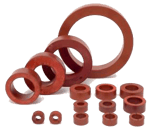Compare
Selected Product
Highlight differences?

DK0130
DK15-02 | Brown Insulating Epoxy resin binder- No longer available
- Summary
- Low shrinkage
- Low moisture absorption
- Binding resin and Coating powder
- For powdered iron core or pot-core type reactors or induction devices
- Blow coating and Fluidized bed application
- Brown, insulating, binding resin
- Low shrinkage
- Low moisture absorption
- Binding resin and Coating powder
- For powdered iron core or pot-core type reactors or induction devices
- Blow coating and Fluidized bed application
- Brown, insulating, binding resin
- General Properties
Particle Size thru 80 mesh 100 % Particle Size thru 325 mesh 26 % Specific Gravity Specific Gravity
Specific gravity (SG) is the ratio of the density of a substance to the density of a reference substance; equivalently, it is the ratio of the mass of a substance to the mass of a reference substance for the same given volume.
For liquids, the reference substance is almost always water (1), while for gases, it is air (1.18) at room temperature. Specific gravity is unitless.1.75 Density (g) 0.74 g/cm3 Color Color
The colorBrown Brown Chemistry Type Epoxy Shelf Life @ 15°C 12 months 12 months - Chemical Properties
Moisture absorption 0.30 % - Mechanical Properties
Edge Coverage 34.2 % - Electrical Properties
Cut Through Temperature Cut Through Temperature
the thermal resistance temperature/ durability380 °C Dielectric Strength Dielectric Strength
Dielectric strength is measured in kV per mm and is calculated by the Breakdown voltage divided by the thickness of the tested material.
Those two properties go hand in hand and while Breakdown voltage is always thickness dependent, dielectric strength is a general material property.
As an example, the dielectric strength of Polyimide is 236 kV/mm. If we place 1mm of Polyimide between two electrodes, it will act as an insulator until the voltage between the electrodes reaches 236 kV. At this point it will start acting as a good conductor, causing sparks, potential punctures and current flow.39 kV/mm Dissipation Factor @ 23°C /100 kHz 0.0173 - Thermal Properties
Gel Time @ 160°C / 320°F 18 seconds Glass Plate Flow Glass Plate Flow
Glass plate flow determines the flow distance of thermosetting epoxies, resins or coating powders on a smooth inclined glass surface in a certain time and temperature.
This value is the distance in millimetres from the upper point of the original position of the pellet to the point of extreme flow.
Typically measured at 150°C but please check the TDS for more info22 mm Glass Transition Temperature (Tg) Glass Transition Temperature (Tg)
The glass transition temperature for organic adhesives is a temperature region where the polymers change from glassy and brittle to soft and rubbery. Increasing the temperature further continues the softening process as the viscosity drops too. Temperatures between the glass transition temperature and below the decomposition point of the adhesive are the best region for bonding.
The glass-transition temperature Tg of a material characterizes the range of temperatures over which this glass transition occurs.155 °C Coefficient of Thermal Expansion (CTE) , α1 Coefficient of Thermal Expansion (CTE) , α1
CTE α1 (alpha 1) is the slope of the Coefficient of thermal expansion in a temperature range below the Glass transition temperature (Tg).
It explains how much a material will expand until it reaches Tg.40 ppm/°C Coefficient of Thermal Expansion (CTE), α2 Coefficient of Thermal Expansion (CTE), α2
CTE α2 (alpha 2) is the slope of the Coefficient of thermal expansion in a temperature range above the Glass transition temperature (Tg).
It explains the extent to which a material will expand after it passes Tg.123 ppm/°C - Other Properties
RoHS Compliant RoHS Compliant
RoHS is a product level compliance based on a European Union Directive which restricts the Use of certain Hazardous Substances in Electrical and Electronic Equipment (RoHS).
Products compliant with this directive do not exceed the allowable amounts of the following restricted materials: lead, mercury, cadmium, hexavalent chromium, polybrominated biphenyls (PBB) and polybrominated diphenyl ethers (PBDE), with some limited exemptionsYes Yes


